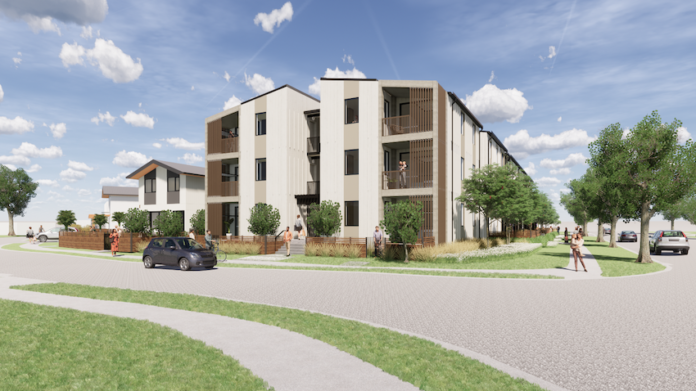
Passive house standards will see tenants saving up to 80% on energy bills over the winter period alone.
Peddlethorp architects has announced the first public housing project funded by central government in Australasia to be built to passive house standards, developed by its client Kainga Ora – Homes and Communities.
The three-storey, 18-home building in Mangere, known as Bader Ventura, is designed to reduce embodied carbon as well as heating costs, with tenants saving up to 80% on energy bills over the winter period alone.
Peddlethorp director Manuel Diaz, who led the architectural design of the development, says Kainga Ora is setting an example of what is possible in the construction industry, and proving that passive housing can work at scale in New Zealand.
“We know the government’s Building for Climate Change programme will mean a quantum shift for our industry, whereby reducing energy consumption and carbon emissions will inform design from the first mark on paper to plans for end-of-life,” Diaz says.
“Because of this programme, the building sector is propelled into a new stage of learning and discovery, and a fresh approach to building design and delivery.”
To ensure new homes are built to be warm, dry and energy efficient, the Building for Climate Change programme will mandate a reduction in thermal demand from 80-90kWh/m2.a (kilowatt hours per square metre per annum) to 15kWh/m2.a by 2035.
The Bader Ventura homes will meet the 2035 energy efficiency standards more than 12 years ahead of schedule.
Construction constitutes 20% of total carbon emissions in New Zealand, and reducing carbon emission is a key priority of government and the private sector in order to meet New Zealand’s international obligations.
“The sustainability strategy for Bader Ventura has influenced all of our choices, from material selection, mechanical systems, structural connections, and construction methodology,” Diaz says.
“We’ve truly worked as a team because to meet the passive house standard, we must have a high degree of collaboration, and a detailed, holistic understanding of building performance before and after construction is complete.”
Kainga Ora general manager construction and innovation Patrick Dougherty says the team is thrilled with the depth and quality of Peddlethorp’s design detailing on such a complex project.
“Peddlethorp’s research-driven design and passion for new technologies have been crucial in helping us achieve passive house design endorsement on Bader Ventura,” Dougherty says.
“Their expertise and commitment to delivering high levels of quality and amenity gives us great confidence in an outstanding final product.”
Diaz says this is no longer business as usual.
“As designers, we are expected to lead the change of direction, and it has been a privilege and an opportunity to work with the wider Kainga Ora network to develop these new homes,” he says.
Design characteristics of a passive house:
• A ventilation system that controls indoor air quality at all times.
• Openings within the building envelope that include thermal breaks and meet high insulation and air tightness requirements.
• A continuous layer of high-performance insulation around the building’s envelope to reduce indoor-outdoor heat transfer.
• Airtight construction preventing uncontrolled air exchange, thereby avoiding mould growth and structural damage.
• Space heating demand that cannot exceed 15kWh annually or 10W (peak demand) per square metre of usable living space.
• Space cooling demand that roughly meets the heat demand with an additional climate-dependent allowance for dehumidification.
• Primary energy demand that doesn’t exceed 120kWh annually for all domestic applications per square metre of usable living space.
• A verifiable air tightness maximum of 0.6 ACH (air changes per hour) at 50 Pascals pressure.
• Year-round thermal comfort for all living areas, with temperatures not exceeding 25°C for more than 10% of the hours in any given year.



